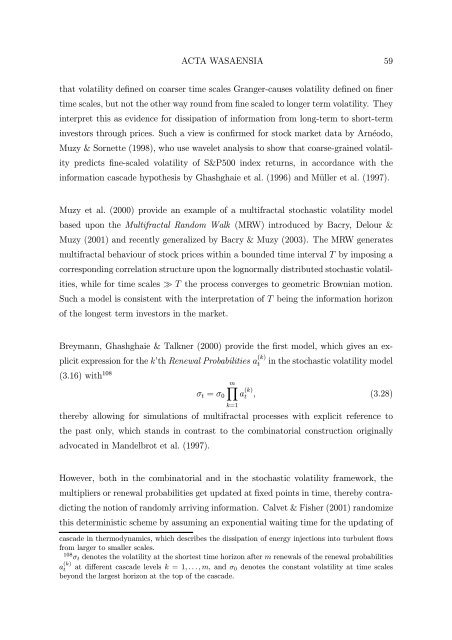BERND PAPE Asset Allocation, Multivariate Position Based Trading ...
BERND PAPE Asset Allocation, Multivariate Position Based Trading ...
BERND PAPE Asset Allocation, Multivariate Position Based Trading ...
You also want an ePaper? Increase the reach of your titles
YUMPU automatically turns print PDFs into web optimized ePapers that Google loves.
ACTA WASAENSIA 59that volatility defined on coarser time scales Granger-causes volatility defined on finertime scales, but not the other way round from fine scaled to longer term volatility. Theyinterpret this as evidence for dissipation of information from long-term to short-terminvestors through prices. Such a view is confirmed for stock market data by Arnéodo,Muzy & Sornette (1998), who use wavelet analysis to show that coarse-grained volatilitypredicts fine-scaled volatility of S&P500 index returns, in accordance with theinformation cascade hypothesis by Ghashghaie et al. (1996) and Mülleretal.(1997).Muzy et al. (2000) provide an example of a multifractal stochastic volatility modelbasedupontheMultifractal Random Walk (MRW) introduced by Bacry, Delour &Muzy (2001) and recently generalized by Bacry & Muzy (2003). The MRW generatesmultifractal behaviour of stock prices within a bounded time interval T by imposing acorresponding correlation structure upon the lognormally distributed stochastic volatilities,while for time scales T the process converges to geometric Brownian motion.Such a model is consistent with the interpretation of T being the information horizonof the longest term investors in the market.Breymann, Ghashghaie & Talkner (2000) provide the first model, which gives an explicitexpression for the k’th Renewal Probabilities a (k)t in the stochastic volatility model(3.16) with 108 σ t = σ 0mk=1a (k)t , (3.28)thereby allowing for simulations of multifractal processes with explicit reference tothe past only, which stands in contrast to the combinatorial construction originallyadvocated in Mandelbrot et al. (1997).However, both in the combinatorial and in the stochastic volatility framework, themultipliers or renewal probabilities get updated at fixedpointsintime,therebycontradictingthe notion of randomly arriving information. Calvet & Fisher (2001) randomizethis deterministic scheme by assuming an exponential waiting time for the updating ofcascade in thermodynamics, which describes the dissipation of energy injections into turbulent flowsfrom larger to smaller scales.108 σ t denotes the volatility at the shortest time horizon after m renewals of the renewal probabilitiesat different cascade levels k =1,...,m,andσ 0 denotes the constant volatility at time scalesa (k)tbeyond the largest horizon at the top of the cascade.
















